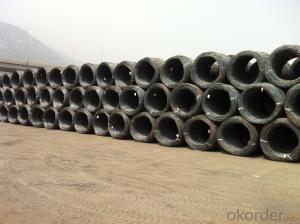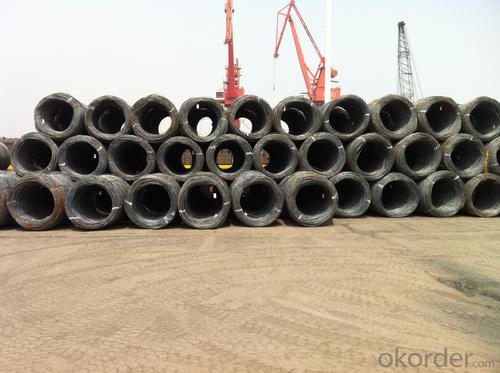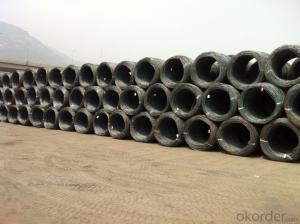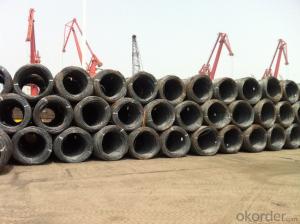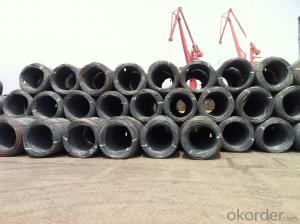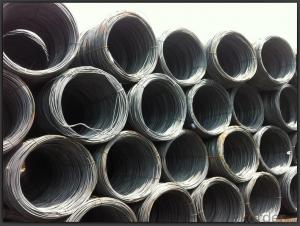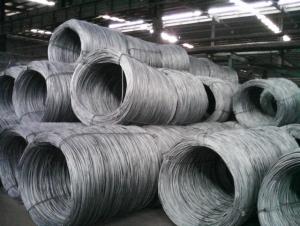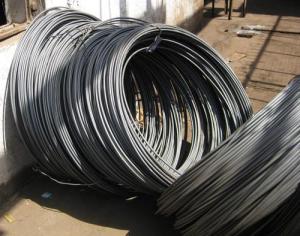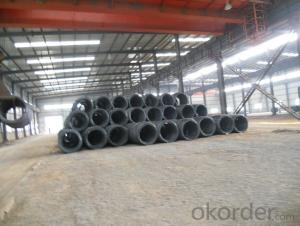SAE1008 Wire Rods with Competitive Price and Quality
- Loading Port:
- Tianjin
- Payment Terms:
- TT OR LC
- Min Order Qty:
- 25 m.t.
- Supply Capability:
- 20000 m.t./month
OKorder Service Pledge
OKorder Financial Service
You Might Also Like
Product Description:
OKorder is offering SAE1008 Wire Rods at great prices with worldwide shipping. Our supplier is a world-class manufacturer of steel, with our products utilized the world over. OKorder annually supplies products to European, North American and Asian markets. We provide quotations within 24 hours of receiving an inquiry and guarantee competitive prices.
Product Applications:
SAE1008 Wire Rods are ideal for structural applications and are widely used in the construction of buildings and the manufacturing, industries.
Product Advantages:
OKorder's Wire Rods are durable, strong, and resist corrosion.
Main Product Features:
· Premium quality
· Prompt delivery & seaworthy packing (30 days after receiving deposit)
· Corrosion resistance
· Can be recycled and reused
· Mill test certification
· Professional Service
· Competitive pricing
Product Specifications:
Manufacture: Hot rolled
Grade: SAE1006 – SAE1008
Certificates: ISO, SGS, BV, CIQ
Length: 6m – 12m, as per customer request
Packaging: Export packing, nude packing, bundled
Grade | Chemical Composition (%) | |||||
C | Mn | S | P | Si | B | |
SAE1006B | 0.03~O.07 | 0.32max | 0.045max | 0.040max | 0.30max | 0.0008min |
Mechanical properties | ||||||
Yield strength(N/mm2) | Tensile strength(N/mm2) | Elongation (%) | ||||
250-280 | 350-380 | ≥32 | ||||
Grade | Chemical Composition (%) | |||||
C | Mn | S | P | Si | B | |
SAE1008B | 0.10max | 0.3~0.50 | 0.050max | 0.040 max | 0.15max | 0.0008 min |
Mechanical properties | ||||||
Yield strength(N/mm2) | Tensile strength(N/mm2) | Elongation (%) | ||||
≥195 | 315-430 | ≥30 | ||||
FAQ:
Q1: Why buy Materials & Equipment from OKorder.com?
A1: All products offered byOKorder.com are carefully selected from China's most reliable manufacturing enterprises. Through its ISO certifications, OKorder.com adheres to the highest standards and a commitment to supply chain safety and customer satisfaction.
A2: Stainless does not "rust" as you think of regular steel rusting with a red oxide on the surface that flakes off. If you see red rust it is probably due to some iron particles that have contaminated the surface of the stainless steel and it is these iron particles that are rusting. Look at the source of the rusting and see if you can remove it from the surface.
Q3: What makes stainless steel stainless?
A3: Stainless steel must contain at least 10.5 % chromium. It is this element that reacts with the oxygen in the air to form a complex chrome-oxide surface layer that is invisible but strong enough to prevent further oxygen from "staining" (rusting) the surface. Higher levels of chromium and the addition of other alloying elements such as nickel and molybdenum enhance this surface layer and improve the corrosion resistance of the stainless material.
Images:
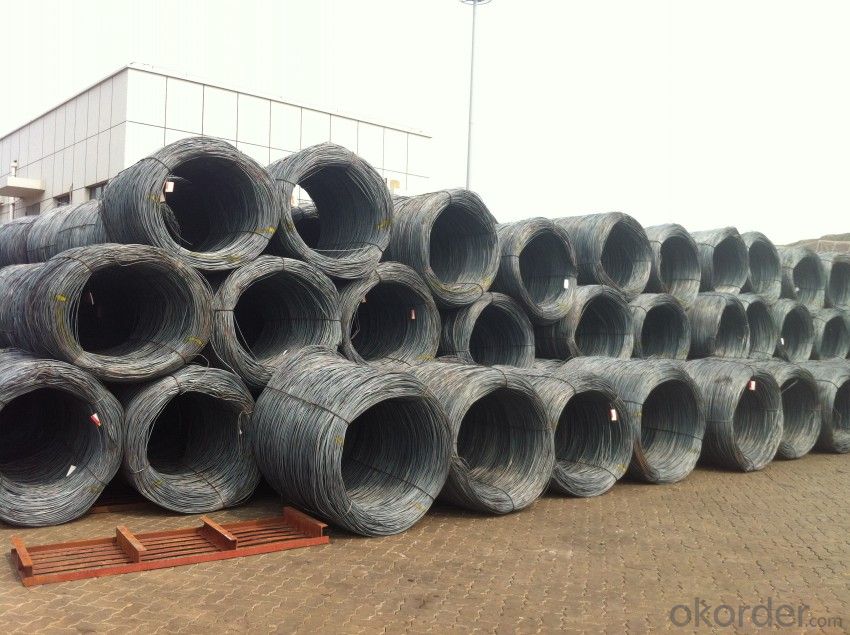

- Q: How does the brittleness of steel wire rod vary with different wire drawing processes?
- The brittleness of steel wire rod can vary with different wire drawing processes. Wire drawing is a metalworking process used to reduce the diameter of a wire by pulling it through a series of dies. The specific wire drawing process used can have a significant impact on the final properties of the wire, including its brittleness. One factor that affects the brittleness of steel wire rod is the reduction in area during the wire drawing process. The reduction in area refers to the amount of material that is removed from the wire as it is drawn through the dies. Higher reductions in area result in a greater degree of deformation and strain on the wire, which can lead to increased brittleness. This is because the grain structure of the steel becomes more elongated and aligned, making it more susceptible to cracking and breaking under stress. Another factor that influences the brittleness of steel wire rod is the speed at which the wire is drawn. Higher drawing speeds can create higher levels of strain and deformation in the wire, which can increase its brittleness. Rapid cooling of the wire during the drawing process can also contribute to brittleness, as it can lead to the formation of brittle phases in the steel microstructure. Furthermore, the heat treatment applied to the wire after the drawing process can also impact its brittleness. Heat treatment processes, such as annealing, can help to relieve internal stresses and improve the ductility of the wire, thereby reducing its brittleness. On the other hand, improper heat treatment or inadequate cooling can result in increased brittleness. In summary, the brittleness of steel wire rod can vary with different wire drawing processes. Factors such as the reduction in area, drawing speed, cooling rate, and heat treatment all play a role in determining the final brittleness of the wire. It is essential for manufacturers to carefully control these parameters to achieve the desired mechanical properties in the wire.
- Q: How is steel wire rod used in the production of wire ropes for ski lifts?
- Steel wire rod is an essential component in the production of wire ropes for ski lifts. The wire rod serves as the raw material from which the wire ropes are manufactured. To begin with, the steel wire rod is carefully selected for its specific properties, such as strength, durability, and flexibility. These characteristics are crucial for ensuring the wire ropes can withstand the heavy loads and constant usage associated with ski lift operations. Once the appropriate steel wire rod is obtained, it undergoes a series of processes to transform it into wire ropes. The wire rod is first cleaned and then heated to a specific temperature to improve its malleability. It is then passed through a series of dies to gradually reduce its diameter and shape it into a continuous length of wire. Next, the individual wires are twisted together to form strands. This twisting process, known as stranding, can vary in configuration depending on the desired strength and flexibility of the wire rope. The strands are then compacted and laid together around a central core, forming the final wire rope structure. The use of steel wire rod in the production of wire ropes for ski lifts offers several advantages. Firstly, steel is known for its high tensile strength, allowing the wire ropes to support heavy loads and provide a safe transportation system for skiers. Additionally, the durability of steel ensures that the wire ropes can withstand the harsh weather conditions and constant exposure to extreme temperatures on mountain slopes. Furthermore, the flexibility of steel wire rod allows the wire ropes to bend and conform to the pulleys and sheaves used in ski lift systems, ensuring smooth and reliable operation. This flexibility is vital in preventing any sudden failure or damage to the wire ropes during their continuous usage. In conclusion, the use of steel wire rod in the production of wire ropes for ski lifts is paramount to ensure the safety, reliability, and durability of these transportation systems. The properties of steel, such as its strength and flexibility, make it an ideal material for constructing wire ropes that can withstand the demanding conditions of ski lift operations.
- Q: How is steel wire rod used in the manufacturing of staples?
- Steel wire rods are an essential component in the manufacturing of staples. These wire rods are typically made from high-quality steel and are available in various diameters. The process of manufacturing staples begins with the steel wire rods being coiled and then drawn through a series of dies to reduce their diameter and increase their length. This drawing process not only enhances the strength of the wire but also ensures its uniformity. Once the desired wire diameter is achieved, the steel wire is cut into smaller lengths, which will determine the size of the staples being produced. These wire lengths are then fed into a specialized staple manufacturing machine, where they undergo a series of operations. Firstly, the wire is fed into a machine that straightens and cleans it to remove any impurities or irregularities. The straightened wire is then cut and shaped into individual staple blanks. These blanks are further processed using a combination of bending, cutting, and shaping operations to form the distinctive "U" shape of the staple legs. Next, the legs of the staples are clinched or bent inwards to create the necessary tension for them to hold papers or other materials together. This process is typically performed using a clinching machine, which applies the necessary force to bend the legs inward, creating the final staple shape. Finally, the manufactured staples undergo a quality control check to ensure that they meet the required standards in terms of dimensions, strength, and overall quality. This may involve checking for proper leg length, uniformity of shape, and testing the staples' ability to hold materials securely. In summary, steel wire rods play a crucial role in the manufacturing of staples by providing the high-strength material necessary for securely holding papers or other materials together. Through a series of processes, the wire rods are transformed into the distinctive "U" shape of staples, ensuring their functionality and reliability for various applications.
- Q: How are steel wire rods packaged and shipped?
- To ensure the safety and integrity of steel wire rods during transportation, a specific packaging and shipping process is followed. This process consists of several steps. Firstly, steel wire rods are typically bound together using steel straps or wires. This bundling process ensures that the rods stay aligned and tightly secured, preventing any potential movement or damage while in transit. Furthermore, it helps maintain the shape and structure of the rods. Once bundled, the steel wire rods are loaded onto pallets or wooden skids. These pallets provide a stable base and allow for easy handling with forklifts or cranes. The rods are carefully placed on the pallets, ensuring proper balance to evenly distribute the weight. After being loaded onto pallets, the steel wire rods are often wrapped with stretch film or other protective material. This wrapping not only secures the rods to the pallet but also shields them from moisture, dust, and other environmental factors during transportation. Additionally, to enhance protection, steel wire rods may be packaged in wooden crates or steel frames. These additional packaging options provide an extra layer of security, safeguarding the rods against potential damage during handling and transportation. Once properly packaged, the steel wire rods are ready for shipping. Depending on factors such as destination and volume, they can be transported via trucks, trains, ships, or airplanes. The choice of transportation method is determined by considerations such as distance, cost, and urgency. During shipping, it is crucial to handle the packaged steel wire rods with care. Appropriate equipment should be used for loading and unloading to minimize the risk of damage. Furthermore, the packages must be adequately secured within the transportation vehicle to prevent any movement or shifting during transit. In conclusion, the packaging and shipping of steel wire rods involve bundling, palletizing, wrapping with protective material, and potentially using additional packaging such as crates or frames. The packaged rods are then transported through various means, ensuring proper handling and security to maintain their quality and integrity.
- Q: How does the elongation of steel wire rod vary with different heat treatment processes?
- The elongation of steel wire rod is influenced by different heat treatment processes. Heat treatment involves subjecting the steel wire rod to specific temperatures and cooling rates to alter its structure and properties. One common heat treatment process for steel wire rod is annealing. During annealing, the wire rod is heated to a high temperature and then slowly cooled. This process relieves internal stresses and allows for the formation of a more uniform and ductile microstructure. As a result, the elongation of the steel wire rod typically increases after annealing. The increased elongation is due to the reduction in brittleness and the improved ability of the material to deform without fracturing. On the other hand, another heat treatment process called quenching and tempering involves rapid cooling followed by reheating and slow cooling again. Quenching hardens the steel wire rod, making it stronger and more resistant to deformation. However, this process can also make the material more brittle, reducing its elongation. The subsequent tempering process relieves some of the brittleness while maintaining the strength, resulting in a moderate elongation. In summary, the elongation of steel wire rod varies with different heat treatment processes. Annealing increases elongation by improving ductility and reducing brittleness, while quenching and tempering can result in a moderate elongation by balancing strength and brittleness. The specific heat treatment process chosen for steel wire rod depends on the desired mechanical properties and performance requirements for its intended application.
- Q: What are the common industry best practices for steel wire rod distributors?
- Some common industry best practices for steel wire rod distributors include maintaining a diverse and well-stocked inventory, ensuring timely delivery to customers, providing excellent customer service and technical support, adhering to quality control standards, collaborating with reputable suppliers, and staying updated on market trends and industry advancements. Additionally, distributors may engage in strategic pricing and promotional activities, invest in efficient logistics and storage facilities, and actively engage in networking and industry associations to stay connected with peers and stay informed about industry developments.
- Q: How is steel wire rod used in the manufacturing of wire for automotive seat belts?
- Steel wire rod is used in the manufacturing of wire for automotive seat belts as it serves as the primary raw material. The rod is first drawn through a series of dies to reduce its diameter and increase its strength. This process, known as wire drawing, ensures that the wire meets the required tensile strength and flexibility standards necessary for seat belt manufacturing. The wire is then further processed, including heat treatment and coating, to enhance its durability and resistance to corrosion. Ultimately, the steel wire rod plays a crucial role in providing the strength and reliability needed for automotive seat belts to effectively restrain passengers during accidents.
- Q: What are the safety considerations when handling steel wire rod?
- When handling steel wire rods, there are several safety considerations to keep in mind. First and foremost, personal protective equipment (PPE) should be worn, including gloves, safety glasses, and steel-toed boots, to protect against potential injuries. Additionally, proper lifting techniques should be utilized to prevent strains or back injuries. It is important to be aware of the weight and balance of the wire rods and to use appropriate lifting equipment if necessary. In terms of storage and transportation, wire rods should be carefully stacked and secured to prevent them from falling or rolling, which could cause injuries. Lastly, workers should be trained on the proper handling procedures and be aware of any potential hazards such as sharp edges or protruding ends of the wire rods.
- Q: What is the typical chemical composition of steel wire rod?
- Steel wire rod can have different chemical compositions depending on its grade and intended use. The main element in steel wire rod is iron, accompanied by small quantities of carbon, manganese, phosphorus, sulfur, and silicon. Carbon plays a significant role in providing strength and hardness to the material. Manganese is commonly added to enhance the steel's hardenability and strength. Phosphorus and sulfur, which are impurities, are typically minimized to avoid negative impacts on the steel's properties. Silicon is incorporated to improve deoxidation and corrosion resistance. It should be noted that the amounts of these elements can vary in different grades of steel wire rod. Additionally, other alloying elements like chromium, nickel, or molybdenum may be included to achieve specific properties required for different applications.
- Q: How is steel wire rod used in the production of wire strands for offshore oil and gas structures?
- Wire strands used for offshore oil and gas structures depend on steel wire rods, which are a vital component. These wire strands consist of multiple steel wires twisted together to create a durable and robust cable. The production process starts with inspecting the steel wire rods for quality and removing any defects. Then, the rods undergo a series of heat treatments to enhance their strength and flexibility. This involves heating the rods to high temperatures and rapidly cooling them through quenching. Quenching improves the mechanical properties of the steel wire rods, making them suitable for the challenging conditions found in offshore environments. After heat treatment, the steel wire rods are drawn through dies to reduce their diameter to the desired size. This wire drawing process ensures that the resulting wire strands have the necessary tensile strength and dimensional accuracy. Once the desired diameter is achieved, the steel wire rods are further processed to form wire strands. Specialized machines twist multiple steel wires together to create a strand with a specific number of wires and lay angle. The lay angle determines the flexibility and strength of the wire strand, which is crucial for offshore applications where high loads and harsh conditions must be endured. The resulting wire strands receive various surface treatments, such as galvanization or coating, to protect against corrosion and ensure longevity in offshore environments. These treatments provide additional protection, allowing the wire strands to withstand exposure to seawater, chemicals, and other corrosive elements commonly encountered in offshore oil and gas structures. Finally, the wire strands are cut to the required lengths and assembled into larger cable structures, such as wire ropes or umbilicals. These cable structures play a vital role in supporting and securing infrastructure within offshore oil and gas structures, ensuring stability and integrity even in extreme conditions. In conclusion, steel wire rod is a crucial element in producing wire strands for offshore oil and gas structures. Through a series of processes, including heat treatment, wire drawing, and twisting, steel wire rods are transformed into strong and durable wire strands capable of withstanding harsh offshore conditions. These wire strands are integral components in constructing and maintaining offshore oil and gas structures by providing stability, support, and protection against corrosion.
Send your message to us
SAE1008 Wire Rods with Competitive Price and Quality
- Loading Port:
- Tianjin
- Payment Terms:
- TT OR LC
- Min Order Qty:
- 25 m.t.
- Supply Capability:
- 20000 m.t./month
OKorder Service Pledge
OKorder Financial Service
Similar products
Hot products
Hot Searches
Related keywords

